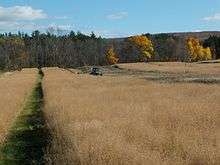Marginal land

Marginal land is land that is of little agricultural value because crops produced from the area would be worth less than any rent paid for access to the area.[1] Although the term marginal is often used in a subjective sense for less-than-ideal lands, it is fundamentally an economic term[2] that is defined by the local economic context. Thus what constitutes marginal land varies both with location and over time: for example, "a soil profile with a set of specific biophysical characteristics reported as “marginal” in the US corn belt may be one of the better soils available in another context".[3] Changes in product values - such as the ethanol-demand induced spike in corn prices - can result in formerly marginal lands becoming profitable.[3]
Land may be marginal for a number of reasons, including poor water supply, poor soil quality, pollution from previous industrial activities, terrain challenges such as excessive slope, or excessive distance from means of transportation.[4]

Marginal land is not entirely useless for human purposes. For example, certain breeds of free-roaming livestock, such as the English Leicester sheep, are able to forage on such land. There are also some plants that can be grown in land that would be considered marginal for most agricultural uses. For example, cucurbita foetidissima, the buffalo gourd, is well adapted to marginal agricultural lands such as sandy loam soils which have to be well-drained.[5][6] Land that is marginal for conventional row-crop production is often well-suited to perennial crops,[7] including low-input crops grown as bioenergy or bioproduct feedtocks such as switchgrass (Panicum virgatum), shrub willow (Salix spp.), and giant miscanthus (Miscanthus x giganteus), allowing production of these crops without inducing competition for prime farmlands.
References
- ↑ William Baumol, Alan Blinder, Economics: Principles and Policy (2011), p. 409.
- ↑ Peterson, GM; Galbraith, J (1932). "The concept of marginal land". Journal of Farm Economics. 14(2): 295–310.
- 1 2 Richards, BK; Stoof, CR; Cary, IJ; Woodbury, PB (2014). "Reporting on marginal lands for bioenergy feedstock production - a modest proposal". BioEnergy Research. 7: 1060–1062. doi:10.1007/s12155-014-9408-x.
- ↑ David Pimentel, Global Economic and Environmental Aspects of Biofuels (2012), p. 92.
- ↑ Bemis, J. (1975). Underexploited Tropical Plants with Promising Economic Value. National Research Council. pp. 94–99. ISBN 978-0-89499-186-8.
- ↑ Nelson, J.; Scheerens, J.; Bucks, D.; Berry, J. (1989). "Irrigation Effects on Water Use, and Production of Tap Roots and Starch of Buffalo Gourd". Agronomy Journal. 81: 439–442.
- ↑ Stoof, CR; Richards, BK; Woodbury, PB (2015). "Untapped potential: Opportunities and challenges for sustainable bioenergy production from marginal lands in New York and the Northeast USA". BioEnergy Research. 8: 482–501. doi:10.1007/s12155-014-9515-8.